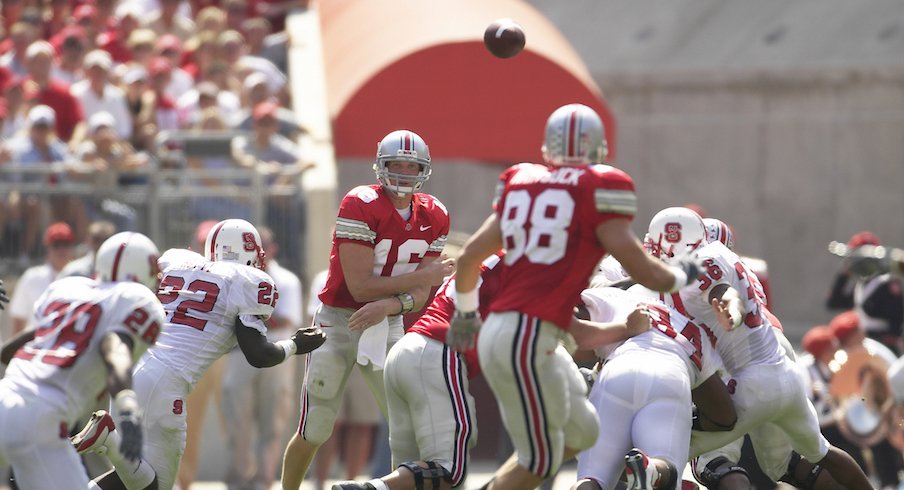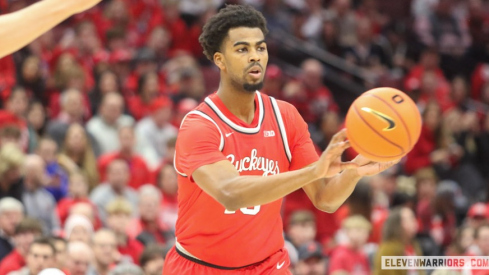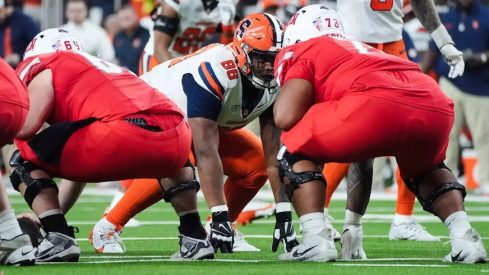Former North Carolina defensive end Beau Atkinson commits to Ohio State.
Ohio State’s 2022 and 2023 non-conference schedules could have been two of its strongest non-conferences schedules ever.
The Buckeyes were scheduled to play alternating home-and-home series with Texas and Notre Dame across those two years, pitting Ohio State against two of college football’s other historic powerhouses for two seasons in a row.
That changed on Wednesday, however, when Ohio State and Texas announced they had moved their home-and-home series back to 2025 and 2026.
Given that the Big Ten moved to a nine-game conference schedule in 2016 – after the future series with Texas and Notre Dame had both already been announced – it’s likely that Wednesday’s announcement to move the series back was years in the making.
Going forward, Ohio State is likely to avoid scheduling multiple home-and-homes to be played in the same year – though the Buckeyes are now scheduled to play both Texas and Washington in 2025 and Texas and Boston College in 2026 – because in order to have seven home games each year, the Buckeyes can only schedule one road non-conference game every two years.
Realistically, that means the opportunities to see Ohio State play two marquee non-conference opponents in future seasons will likely be far and few between.
Still, it got us thinking back on schedules of Ohio State’s past, when it was far more common for big-time college football programs to face two or even three opponents of national prominence in their non-conference schedules.
Unlike now, when the Buckeyes (and other Power 5 teams) typically play at least two non-conference games against non-Power 5 opponents, it used to be commonplace for Ohio State to play all of its games against teams who were or who would now considered Power 5 teams.
As such, the Buckeyes’ non-conference schedules from before the turn of the century tend to stand out far more than their more recent non-conference slates. But taking that into consideration, we’ve taken a look back to 1975 and highlighted some of the seasons that put the Buckeyes to the biggest test or featured their most marquee matchups outside of conference play.
1975: No. 7 Penn State, North Carolina, No. 13 UCLA
1976: No. 7 Penn State, Missouri, No. 4 UCLA
Ohio State played alternating home-and-home series with Penn State (which was an independent until it joined the Big Ten in 1993) and UCLA in 1975 and 1976, and the Buckeyes, Nittany Lions and Bruins were each ranked in the top 13 nationally for all four games. With games against other teams from major conferences in between the Penn State and UCLA games each year, the Buckeyes had back-to-back tough trios of non-conference contests, both of which came after season openers against Michigan State.
With reigning Heisman Trophy winner Archie Griffin leading the way in 1975, the Buckeyes earned a 17-9 win over Penn State at Ohio Stadium, a 32-7 win over North Carolina at Ohio Stadium and a 41-20 win over UCLA at the L.A. Coliseum to sweep their non-conference slate. The Buckeyes went on to win all 11 of their regular season games, with Griffin becoming the first and still only player to win two Heisman Trophies, before suffering a 23-10 loss to UCLA in a Rose Bowl rematch.
With Griffin gone in 1976, however, the tough non-conference slate got the best of the Buckeyes. While the then-No. 2-ranked Buckeyes earned a 12-7 win over Penn State at Beaver Stadium, they suffered a 22-21 home loss to unranked Missouri the following week, followed by a 10-10 tie in their rubber match with UCLA at Ohio Stadium.
1980: Syracuse, No. 20 Arizona State, No. 11 UCLA
After entering the 1980 season as the No. 1-ranked team in the country, Ohio State was quickly put to the test by its non-conference schedule. While the Buckeyes’ season-opening 31-21 win came against an unranked Syracuse at Ohio Stadium, and that was followed by a 47-0 blowout win in their Big Ten opener against Minnesota at Ohio Stadium, those two games were followed by back-to-back games against ranked teams from the Pac-10.
Ohio State took care of business against the No. 20-ranked Sun Devils, defeating them 38-21 at the Shoe. When No. 11 UCLA came to Columbus one week later, however, the Buckeyes were shut out, 17-0.
The Buckeyes bounced back from that loss to win their next six games, but finished the 1980 season with losses to Michigan and to Penn State in the Fiesta Bowl.
1986: No. 5 Alabama, No. 17 Washington, Colorado, Utah
While the 12-game schedule didn’t come to college football until 2006, teams were allowed to play 12 regular-season games when they participated in the Kickoff Classic, a season-opening game held at Giants Stadium from 1983 to 2002. Ohio State faced Alabama in the fourth annual Kickoff Classic in 1986, and as such, the Buckeyes played a four-game non-conference slate for the first time.
That also meant a daunting two-game stretch for Ohio State to open the season, as they travelled to face a ranked Washington team at Husky Stadium after the Kickoff Classic, and that challenge got the better of the Buckeyes. After suffering a 16-10 loss to the Crimson Tide, the Buckeyes took a 40-7 blowout defeat in Seattle.
The Buckeyes bounced back, though, in their final two non-conference games, defeating Colorado 13-10 before drubbing Utah, 64-6, in their only “cupcake” game of the year (against an opponent who would no longer be considered a cupcake). Ohio State went on to win nine straight games before losing its regular-season finale to Michigan.
1995: No. 22 Boston College, No. 18 Washington, Pittsburgh, No. 15 Notre Dame
The Buckeyes appeared in the Kickoff Classic again in 1995, and while their season-opening matchup wasn’t quite as tough this time around – they blew out Boston College, 38-6, in the game at Giants Stadium – they ended up doing something they hadn’t done before and haven’t done since: Playing three regular-season non-conference against ranked opponents.
This time around, the Buckeyes hosted Washington after playing in the Kickoff Classic, and they beat the Huskies this time, 30-20. After blowing out Pittsburgh, 54-14, on the Panthers’ home turf, the Buckeyes capped their non-conference slate with a 45-26 win over Notre Dame at Ohio Stadium.
By virtue of their three wins over ranked teams, the Buckeyes rose from their No. 12 preseason ranking to No. 5 by the time they opened conference play. The Buckeyes went on to win their first 11 games of the year, rising all the way to No. 2 in the national rankings, before losing their final two games of the season at Michigan and against Tennessee in the Citrus Bowl.
1998: No. 11 West Virginia, Toledo, No. 21 Missouri
1999: No. 12 Miami (Fla.), No. 14 UCLA, Ohio, Cincinnati
Ohio State’s days of playing three or more non-conference games against Power 5 opponents came to an end by the end of the 1990s, when the Buckeyes began scheduling more non-conference games against in-state schools, but the Buckeyes still ended up playing a pair of ranked non-conference games in both 1998 and 1999.
The Buckeyes entered the 1998 season as the No. 1-ranked team in the country, and only strengthened their standing with their play against their strong non-conference slate. Ohio State opened its season with a 34-17 win on the road over No. 11 West Virginia. After cruising to a 49-0 victory in their home opener against Toledo, the Buckeyes won by three touchdowns (35-14) against No. 21 Missouri. The Buckeyes went on to win all but one of their games that season, suffering a 28-24 loss to Michigan State in November, and finished the year as the No. 2 team in college football.
Ohio State returned to the Kickoff Classic in 1999, and suffered a 23-12 loss in their season opener against the No. 12-ranked Miami Hurricanes. Once again tasked with following up their trip to the Kickoff Classic with another ranked game, though, the Buckeyes bounced back strong, defeating UCLA 42-20. The Buckeyes took care in subsequent home games against Ohio, 40-16, and Cincinnati, 34-20, but struggled in Big Ten play, finishing the 1999 season with a record of just 6-6.
2003: No. 17 Washington, San Diego State, No. 24 N.C. State, Bowling Green
The last time Ohio State faced multiple ranked opponents in non-conference play – which could remain the final time for many years to come – came in 2003. The Buckeyes faced a pair of Power 5 opponents in non-conference games, which they’ve only done once since (Miami and Colorado in 2011), and both Washington and N.C. State ended up coming to Ohio Stadium as ranked opponents.
The primetime season opener against Washington actually proved to be the easiest non-conference game for the Buckeyes, as they defeated the Huskies, 28-9.
The No. 2-ranked Buckeyes, coming off a national championship the season before, surprisingly struggled in their second game of the season against San Diego State, only winning 16-13 against the Aztecs.
Ohio State’s third game of the season against Philip Rivers and No. 24 N.C. State proved to be a battle royale, going three overtimes before the Buckeyes finally beat the Wolfpack, 44-38. And the Buckeyes ended up in another surprisingly close game the following week against Bowling Green, only winning 24-17. Still, the Buckeyes went 4-0 in their toughest non-conference slate since the turn of the century, though they finished the 2003 season with an 11-2 record after losing to Wisconsin and Michigan in Big Ten play.


